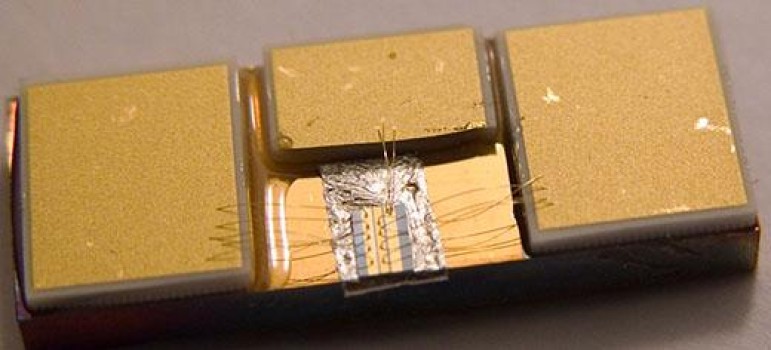
University of Leeds researchers have taken the lead in the race to build the world's most powerful terahertz laser chip.
 A paper in the Institution of Engineering and Technology's (IET) journal Electronics Letters reports that the Leeds team has exceeded a 1 Watt output power from a quantum cascade terahertz laser.
A paper in the Institution of Engineering and Technology's (IET) journal Electronics Letters reports that the Leeds team has exceeded a 1 Watt output power from a quantum cascade terahertz laser.
The new record more than doubles landmarks set by the Massachusetts Institute of Technology (MIT) and subsequently by a team from Vienna last year.
Terahertz waves, which lie in the part of the electromagnetic spectrum between infrared and microwaves, can penetrate materials that block visible light and have a wide range of possible uses including chemical analysis, security scanning, medical imaging, and telecommunications.
Widely publicised potential applications include monitoring pharmaceutical products, the remote sensing of chemical signatures of explosives in unopened envelopes, and the non-invasive detection of cancers in the human body.
However, one of the main challenges for scientists and engineers is making the lasers powerful and compact enough to be useful.
Professor Edmund Linfield, Professor of Terahertz Electronics in the University's School of Electronic and Electrical Engineering, said: "Although it is possible to build large instruments that generate powerful beams of terahertz radiation, these instruments are only useful for a limited set of applications. We need terahertz lasers that not only offer high power but are also portable and low cost."
The quantum cascade terahertz lasers being developed by Leeds are only a few square millimetres in size.
In October 2013, Vienna University of Technology announced that its researchers had smashed the world record output power for quantum cascade terahertz lasers previously held by Massachusetts Institute of Technology (MIT). The Austrian team reported an output of 0.47 Watt from a single laser facet, nearly double the output power reported by the MIT team. The Leeds group has now achieved an output of more than 1 Watt from a single laser facet.
Professor Linfield said: "The process of making these lasers is extraordinarily delicate. Layers of different semiconductors such as gallium arsenide are built up one atomic monolayer at a time. We control the thickness and composition of each individual layer very accurately and build up a semiconductor material of between typically 1,000 and 2,000 layers. The record power of our new laser is due to the expertise that we have developed at Leeds in fabricating these layered semiconductors, together with our ability to engineer these materials subsequently into suitable and powerful laser devices."
Professor Giles Davies, Professor of Electronic and Photonic Engineering in the School of Electronic and Electrical Engineering, said: "The University of Leeds has been an international leader in terahertz engineering for many years. This work is a key step toward increasing the power of these lasers while keeping them compact and affordable enough to deliver the range of applications promised by terahertz technology."
This work was mainly funded by the Engineering and Physical Sciences Research Council (EPSRC).

 Previous page
Previous page Back to top
Back to top







